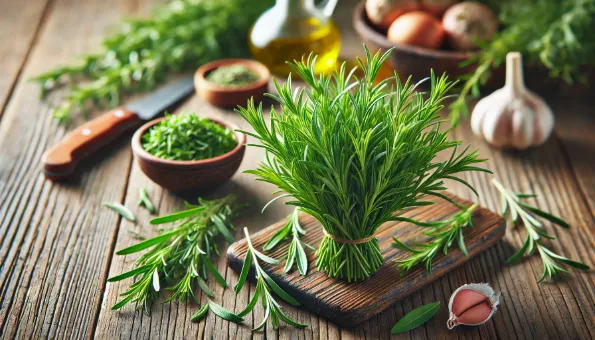Tarragon: Anise-Licorice Herb for Sauces, Chicken & Eggs
Fragrant herb with gentle anise notes—classic in Béarnaise, great with poultry, fish and eggs. Use French tarragon for best flavor.

What Is Tarragon?
Tarragon (*Artemisia dracunculus*) is a tender herb with **anise/licorice** aroma. **French tarragon** is prized for its bright, peppery-sweet flavor; **Russian tarragon** is milder and less aromatic.
Nutrition (1 tbsp fresh ~2 g)
≈**2 kcal**, negligible carbs/fat/protein; contains small amounts of **polyphenols** and **potassium**. Used primarily as a **flavoring**.
Culinary Benefits
- **High impact flavor** lets you use **less salt**.
- Pairs with **butter, cream, mustard, lemon**, and **white wine** sauces.
- Brightens **chicken, turkey, fish, eggs, potatoes, mushrooms**.
Possible Downsides
- Strong flavor—**overuse can dominate**.
- Member of the **Asteraceae** family; rare **allergies** possible.
- Contains **estragole**; stick to **culinary amounts**, especially during pregnancy/nursing.
How to Use
- Finish sauces like **Béarnaise**; add near the end to preserve aroma.
- Make **tarragon vinegar** (steep fresh sprigs 1–2 weeks).
- Stir into **omelets, chicken salad, compound butter**.
- Works in **Herbes de Provence** blends.
- **Conversion:** ~**1 tbsp fresh = 1 tsp dried**.
Tip
Use **French tarragon** where possible. Keep leaves **whole or roughly chopped** and add **off heat**. Store fresh sprigs wrapped and refrigerated; or freeze in butter/ice cubes.
- 1. Tarragon
Tarragon (estragon) – *Artemisia dracunculus*; **French tarragon** (intenzivniji, anis/likoric nota) vs **Russian tarragon** (blaži). Klasičan u **Béarnaise** sosu; odličan uz piletinu, jaja, ribu, krompir, senf, sirće.

